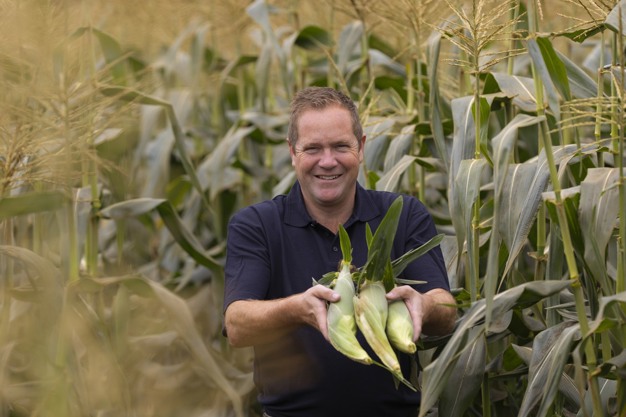Thirty years ago, while still a student, Giel Hermans began growing sweetcorn in the Netherlands. A teacher made him aware of this product's potential, given the high consumption in the United States. "I figured it can't be worse; I'm going to give it a try. So, I started growing on half a hectare," he begins.

When Giel started out, he thought he was the only one in the country who saw the value in sweet corn cultivation. But Giel soon discovered more pioneers in the field, like Jos de Regt, who he met at a local trade show. While De Regt eventually focused on frozen corn, Giel stuck to the fickle fresh market.
Trade secrets
In the early days, one of the vital factors for Hermans' success was variety choice. There were sweet corn varieties in the Netherlands, but they did not meet the aesthetic and quality requirements Giel wanted. He found seed suppliers with much higher quality varieties in the U.S. Those varieties had more grains per cob, resulting in a significant lead for the entrepreneur in the Dutch market. Introducing these superior varieties gave him an edge he managed to maintain for 20 years until a European firm acquired the breeder.
Giel, however, points out that choosing a good variety is only part of the success story. Finding follow-up varieties that fit in seamlessly under different weather conditions is a skill in itself, one which he has mastered. Something, says Giel, that takes years of experience and testing.
Sales product
From the start, Hermans had a clear idea of how he wanted to market his sweetcorn. He did not believe in the traditional auction model, where growers put their produce in front of the clock and are then at the mercy of market whims. Giel went straight to the chain stores, literally with corn cobs under his arm. That proved a good move, as stores like Albert Heijn soon showed interest in his products. This Dutch supermarket chain was already familiar with French sweetcorn but was open to working with a local grower. This partnership laid the foundation for a long-term relationship, and, to this day, Albert Heijn still carries Dutch-grown sweetcorn.
When Giel started, his buyers wanted him to supply sweetcorn year-round. That required an extensive network of growers in France, Spain, Morocco, and the United States who could collectively meet the demand. Corn imports from Florida and Georgia did especially well for a long time until market conditions changed, and Hermans switched to Senegal.
Challenge
Initially, it was challenging to get Dutch consumers to accept fresh sweetcorn. Giel recalls how often he stood at markets trying to convince people that sweet corn was not just cattle feed. One time, customers could shuck their own corn in the store, leading to a chaotic but successful day of sales.
Besides retailers, Hermans Suikermaïs owes much of its success to Dutch fresh produce exporters, who introduced the product to overseas markets. Exotics traders such as BUD, TFC, Westland Import, and Nature's Pride soon became clients and remain so. Scandinavia, Switzerland, and Austria were particularly important export markets for Giel. As was the United Kingdom, but he largely lost that market after Brexit. The Netherlands' strong logistics position means Hermans can also supply sweetcorn in bulk to growers and packers abroad.
Consumption has doubled
In the Netherlands, sweetcorn consumption has doubled through the years, from 40 to 80 g per capita. That is thanks to Giel and his colleagues. While this is an admirable achievement, the trader/grower still sees much growth potential, especially considering consumption in the United States, where the average American consumes no less than 10 kilograms of sweet corn annually. He believes the category can expand even further if given enough attention. The rising vegan trend and growing popularity of barbecues contribute to this growth. It also helps when TV chefs promote corn; that directly increases sales.
Hermans notes that overseas factors positively affect Dutch sweetcorn consumption, too. Many people try corn dishes while on vacation and bring these experiences home. The Netherlands may never reach the level of consumption of the U.S., but Giel, nonetheless, remains optimistic about sweet corn's future in the Netherlands.
 Hermans Suikermaïs
Hermans Suikermaïs
Donk 1a
5995 PL Kessel (Limburg)
Tel: +31 (0) 77 4629325
Mob: 0651312426
con@mielies.nl
www.mielies.nl
